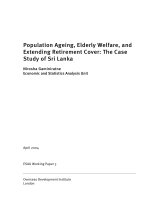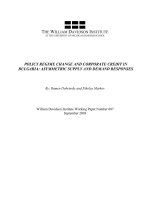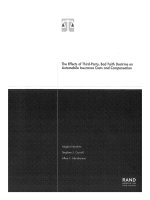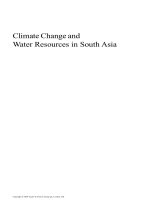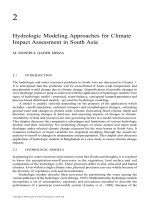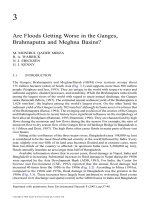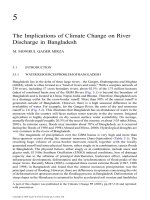Effects of landuse change and forest fragmentation on the biodiversity and ecosystem functioning in the tropical lowlands of sri lanka
Bạn đang xem bản rút gọn của tài liệu. Xem và tải ngay bản đầy đủ của tài liệu tại đây (1.52 MB, 197 trang )
EFFECTS OF LANDUSE CHANGE AND FOREST FRAGMENTATION ON THE
BIODIVERSITY AND ECOSYSTEM FUNCTIONING IN THE TROPICAL
LOWLANDS OF SRI LANKA
ENOKA PRIYADARSHANI KUDAVIDANAGE
B.Sc. (Zoology), M.Sc (Environmental Sciences)
A THESIS SUBMITTED FOR THE DEGREE OF
DOCTOR OF PHILOSOPHY
DEPARTMENT OF BIOLOGICAL SCIENCES
NATIONAL UNIVERSITY OF SINGAPORE
2011
1
“The forest is a peculiar organism of unlimited kindness and benevolence that makes no
demands for its sustenance and extends generously the products of its life activity; it provides
protection to all beings, offering shade even to the man who destroys it.”
— Gautama Buddha
i
Dedicated to my parents
ii
ACKNOWLEDGEMENTS
I am grateful to late Prof. Navjot Sodhi, my ex-supervisor whose unique combination of
intelligence, determination, intimidation and social skills defined my path into the field of
conservation biology. I am indebted, to my supervisor Prof. Edward Webb for persuasion and
guidance that enabled me to complete the PhD thesis, and to the constant encouragement
provided by Prof. Richard Corlett. I extend my gratitude to Prof Sarath Kotagama, my supervisor
in Sri Lanka, and mentor for the last 15 years, for his guidance provided throughout my
academic life. I thank all examiners for their most valuable and helpful comments that were
adopted in the final version of my thesis.
Many thanks to all the past and present staff member and colleagues of the Conservation
Ecology, Applied Plant Ecology laboratories and the terrestrial ecology group including Daniel
Friess; David Bickford; Mary Rose Posa, Nanthinee Jeevanadam, Reuben Clement, Arvin
Diesmos and Lee Wei Kit; the technical and administrative staff including Tommy Tan, Reena
Devi Samayanadan, Priscilla Lee, members of the Biodiversity group and the Raffles Museum
for Biodiversity research of the Department of Biological Sciences for all the encouragement
assistance and inspiration extended in one-way or another. Special thanks towards Janice Lee
and Qie Lan, my fellow dung girls for the comradeship of dung beetles. Prof. David J. Lohman
(Lohman Lab, City College of New York) is kindly acknowledged for extending a generous
helping hand in many challenges faced during my PhD study including correcting manuscripts,
assisting analytical problems, helpful discussions and providing resources.
I’m grateful to Darren J. Mann, Eleanor Slade and the staff of the Oxford University
Museum of Natural History for patiently guiding me through the intense process of species
identification and for the opportunity to use the scarab beetle collection at the American Museum
iii
of Natural History. Thanks to the ScarabNet research team including Finbarr Horgan for sharing
with me their knowledge about dung beetles. I acknowledge all my collaborators; Thomas
Wanger (Center for Conservation Biology , Stanford University), Neil Collier (Lohman Lab,
City College of New York) for analytical work; Priyadarshan Dharmarajan (Ashoka Trust,
India), Manori Gunetilleke (National Museums, Sri Lanka) and Deepchandi Lekamge
(Sabaragamuwa University) for the taxonomic study.
I acknowledge the Department of Wildlife Conservation and the Forest Department, Sri
Lanka for granting me access to work in the protected area and permission to export specimen
for taxonomic work. I thank the Vice- Chancellor of the Sabaragamuwa University of Sri Lanka
and the Department of Natural Resources for kindly facilitating my graduate studies. Gratitude
extended to Professors Nimal Gunatilleke, Savithri Gunatilleke and Drs. Eben and Uromi
Goodale for expertise knowledge, guidance and helpful discussions. Ravi Amarasinghe,
Chamitha de Alwis, Vimukthi Herath, Krishan and Udeni Ariyasiri, Vishan, Amila Perera,
Nuwan Hegodaaarachchi, the Wildlife Conservation Society of Galle and the local assistants
who supported the field work are acknowledged.
The Field research was funded by NAGAO Natural Environmental Foundation, Japan
and Joe Grove memorial award, UK, while the taxonomic study was funded by the Oxford
University Museum of Natural History, London. The World Bank sponsored IRQUE project and
the National University of Singapore Research Scholarship supported the PhD studies.
Finally, I thank everybody including my family who stood by me extending their constant
support, patience and understanding through the graduate studies. I owe all that I am to my
parents, who made it their lifetimes’ goal to help me fulfill my dreams. I remember with heartfelt
gratitude and warmth, my father who passed away one month before I entered the graduate
iv
school of his choice and my mother who stood by me all my life before she passed away seven
months ago. She shared my love for nature and all living things, supported my chosen career and
enjoyed every one of my field expeditions, participating with great enthusiasm. This thesis is a
product of her faith in me.
v
C
ontents
ACKNOWLEDGEMENTS iii
THESIS SUMMARY 1
LIST OF FIGURES 4
LIST OF TABLES 5
APPENDICES 6
CHAPTER 1: GENERAL INTRODUCTION 7
CHAPTER 2: STUDY SITE 13
2.1 Sri Lanka and the Lowland Wet Zone: a biodiversity hotspot 13
2.2 From game protection to biodiversity conservation: the history and status of biodiversity
conservation in the wet zone of Sri Lanka 15
2.3 Study sites: Sinharaja, Kanneliya and Kottawa 20
2.3.1 Sinharaja Man and Biosphere Reserve 20
2.3.2 Kanneliya conservation forest 23
2.3.3 Kottawa Kombala conservation forest 24
CHAPTER 3: AMPHIBIAN AND BUTTERFLY DIVERSITY ACROSS A LOWLAND TROPICAL
LAND-USE GRADIENT IN SRI LANKA 28
3.1 Introduction 28
3.2 Materials and methods 29
3.2.1 Study area 29
vi
3.2.2 Sampling diversity and abundance 30
3.2.3 Environmental variables 31
3.2.4 Analysis of species richness and abundance data 32
3.2.5 Analysis of environmental variables 33
3.3 Results 34
3.3.1 Butterflies 34
3.3.2 Amphibians 35
3.3.3 Environmental determinants 37
3.4 Discussion 38
3.4.1 Butterfly response to land-use change 38
3.4.2 Amphibian response to land-use change 40
3.4.3 Environmental predictors of butterfly and amphibian diversity patterns 42
3.5 Conclusions 43
4.1 Introduction 51
4.2 Dung beetles (Insecta: Coleoptera: Polyphaga: Scarabaeoidea: Scarabaeidae: Scarabaeinae and
Aphodiinae) 51
4.2 Materials and methods 53
4.2.1 Study site 53
4.2.2 Beetle sampling and identification 54
4.3 Results and discussion 55
4.3.1 Species distribution overview 55
4.3.2 Species distribution in contrast to previous records 56
vii
4.3.4 Possible natural and anthropogenic environmental determinants of observed distribution
patterns of dung beetle species 58
4.3.5 Limitations and future work 62
CHAPTER 5: EFFECTS OF LAND-USE CHANGE ON THE COMMUNITIES OF DUNG BEETLES
IN LOWLAND TROPICS OF SRI LANKA 67
5.1: Introduction 67
5.4 Materials and methods 70
5.4.3 Beetle sampling 71
5.5 Data analysis 72
5.8 Conclusion 84
CHAPTER 6 DUNG BEETLE COMMUNITIES IN LOWLAND FOREST FRAGMENTS 90
6.1 Introduction 90
6.2 Study site 94
6.3 Materials and methods 94
6.3.1 Dung beetle sampling 94
6.3.2 Environmental variables and fragment characteristics 95
6.3.3 Fragment characteristics 95
6.4 Data analysis 96
6.4.1 Summary statistics and community parameters 96
6.4.2 Comparison of species richness, abundance across the fragments 96
6.5 Results 99
6.5.1 Community comparison 100
viii
6.5.2 Relating species richness, abundance, fragment characteristics and environmental variables 101
6.6 Discussion 104
6.7 Conclusion 111
CHAPTER 7 HABITAT CHANGE IMPAIRS ECOLOGICAL SERVICES PROVIDED BY
SCARABAEINAE DUNG BEETLES IN THE TROPICAL LOWLANDS OF SRI LANKA 122
7.1 Introduction 122
7.2. Materials and methods 123
7.2.1 Study area 123
7.2.2 Sampling design for dung removal and dung beetle trapping 123
7.2.3 Dung removal experiments 124
7.2.4 Beetle sampling 125
7.2.5 Statistical analysis 125
7.3. Results 126
7.4. Discussion 127
7.4.1 Functional responses of dung beetles 127
7.4.2 Economic implications for conservation 129
7.5 Conclusions 131
CHAPTER 8: GENERAL DISCUSSION – RESEARCH FINDINGS AND THEIR APPLICABILITY
137
8.1 Ecological trends 137
8.2 Conservation implications 143
BIBLIOGRAPHY 150
ix
x
APPENDICES 184
1
1
2
3
4
5
6
7
8
9
10
11
12
13
14
15
16
17
18
19
20
21
22
23
24
THESIS SUMMARY
Habitat disturbance caused by the rapid expansion of agriculture and anthropogenic land use
severely impact native forest biota. Resulting changes in the environment include altered
biotic community composition and ecosystem functions. The present study examines the
effects of land use change and forest fragmentation on biodiversity and ecosystem
functioning in Sri Lanka using community data. This study was conducted in the lowland wet
zone, the most species-rich zone of Sri Lanka, but which has been severely affected due to
logging and conversion to agriculture and home gardens. This is the first ecological study to
be conducted in the area that encompasses several modified land use types. Throughout this
thesis, selected modified land use types; old selectively logged forest, monoculture
plantations, home gardens and forest fragments, are compared with primary forests to
evaluate the effects of habitat disturbance. Amphibians, butterflies and Scarabaeinae dung
beetles were chosen as focal taxa in this study because they are known to be among the best
indicators of habitat disturbance due to their sensitivity to habitat changes and cost efficiency
of sampling. In the second chapter, I provide background information to Sri Lanka’s
conservation history at the study sites. Chapter three examines effects of anthropogenic land
use and selective logging by surveying the diversity and community composition of
amphibians and butterflies in primary forest and across the chosen land use types. I found
that amphibians, specially endemics and direct developing species were more susceptible to
habitat modification than butterflies in the lowland wet zone landscape. The environmental
determinants of the communities indicated that structural variables of the habitats were more
important for amphibians, while butterflies communities were more responsive to climatic
variables. In chapter 4, I include a taxonomic update, distribution maps, and a photographic
guide to the Sri Lankan Scarabaeinae beetles, including potentially new species and new
2
1
2
3
4
5
6
7
8
9
10
11
12
13
14
15
16
17
18
19
20
21
22
23
24
records for Sri Lanka. The reference collection, established from island wide sampling and
verified with type specimens, was used to identify specimens gathered during ecological data
collection. Analysis of species distributions revealed that dung beetle diversity was correlated
with the mammal diversity across the bioclimatic zones of the island. In chapters five and six,
I report the diversity and abundance of Scarabaeinae beetles in multiple land use areas over a
wide geographic range and twenty forest fragments in the lowland wet zone. I found that
diversity and abundance negatively responded to anthropogenic land use in tea plantations
and home gardens, primarily through altered abundance and community composition; total
species richness was less affected. Communities in more than 70% of forest fragments were
significantly different from the primary forest and those differences were best explained by
fragment area, area to edge ratio and some abiotic and structural environmental variables (i.e.
soil temperature, soil pH, maturity of the forest indicated by DBH profile). Finally, I relate
dung beetle species richness and abundance to ecosystem functioning by studying dung
removal across the same gradient of land-use change, and then discuss how disturbances can
affect dung removal service and nutrient recycling. Dung removal was negatively affected by
land use change, primarily through altered abundance and functional group diversity. Further,
I discuss the importance of restoring nutrient enrichment of soil through dung removal, and
the potential economic benefits for agriculture. This dissertation provides the most coherent
picture to date of how amphibians, butterflies, and mostly Scarabaeinae dung beetles are
affected by land use change and forest fragmentation in Sri Lanka, and how ecosystem
functioning of dung beetles is influenced by habitat modification. In addition, the study
surmounts some of the hurdles to tropical conservation research by supplementing the limited
knowledge on ecological effects of habitat disturbance in South Asia specifically by
highlighting an ecologically little known country in the region. The research findings can be
3
1
2
3
4
5
6
7
8
used to make scientifically informed recommendations for the conservation of pristine forests
and management of anthropogenic land use areas to increase their conservation value.
4
1
2
LIST OF FIGURES
Figure 2.1 Major climatic zones of Sri Lanka
Figure 2.2 Map of Sri Lanka and the study sites
Figure 2.3 Categories of peer reviewed publications from the Sinharaja forest
Figure 3.1 Map of the Sinharaja forest-lowland sector
Figure 3.2 Nonmetric multidimensional scaling ordination of Bray-Curtis similarity
indices for butterflies and amphibians
Figure. 4.1 Major bio-climatic zones of Sri Lanka and sampling locations of the
island wide dung beetle survey
Figure 4.2 Dung beetle trap designs used during the study
Figure. 4.3 Distribution of dung beetle species according to body size, across the bio-
climatic zones
Figure 5.1 Nonmetric multidimensional scaling ordination of Bray-Curtis similarity
indices for dung beetles
Figure 5.2 Relating the land use and environmental variables to dung beetle richness
abundance data using Constrained Correspondence Analysis
Figure 5.3 Recursive partitioning analysis of the average species richness in the
landscape.
Figure 6.1 Locations of the sampled forest fragments
Figure 6.2 Recursive partitioning analysis of the species richness and abundance data
vs. fragment characteristics.
Figure 6.3 Constrained Correspondence analysis: species richness and abundance
data vs. fragment characteristics and environmental variables
Figure 7.1 Average percentage of cow dung removal by dung beetles in four habitat
types and two seasons
Figure 7.2 Correlation of fertilizer use and tea production in Sri Lanka ( 1961 –
2002)
5
1
2
LIST OF TABLES
Table 3.1 Summary statistics of butterfly and amphibian sampling
Table 3.2 Environmental determinants of butterfly species richness and abundance
Table 3.3 Environmental determinants of amphibian species richness and
abundance
Table 5.1 Summary statistics of dung beetle species richness, abundance and
biomass of habitat types
Table5. 2 Summary of results from the generalized mixed-effects models for the
effect of land-use change on species richness
Table 5.3 Community similarity among land use types quantified by Morrisita
Horn index
Table 6.1 Summary statistics of dung beetle species richness and abundance of
individual forest fragments.
T able 6.2a Summary of community parameters calculated for 20 forest fragments
Table 6.2b Community similarity among fragments compared using two measures
Table 6.3 Generalized linear models: fragment characteristics as determinants of
dung beetle species richness.
Table 7.1 Dung removal as a function of temporal and spatial parameters in the
lowland wet zone of Sri Lanka.
Table 7.2 Dung removal as a function of species richness and abundance of
different dung beetle guilds
6
1
2
3
APPENDICES
Appendix 3.1 Distribution and endemism of butterfly species in a lowland wet zone
landscape, Sri Lanka
Appendix 3.2 Species accumulation, population abundance and rarefaction curves for
butterflies in sampled habitat types
Appendix 3.3 Summary statistic of the multi-response permutation procedure results
for community comparison of amphibians and butterflies
Appendix 3.4 Distribution, endemism and conservation status of amphibian species in
a lowland wet zone landscape, Sri Lanka
Appendix 3.5 Species accumulation, population abundance and rarefaction curves for
amphibians in sampled habitat types
Appendix 3.6 (a) Environmental variables that best describe the species richness and
abundance of butterflies and amphibians in all sampled habitats and (b)
the correlation matrix.
Appendix 4.1 Species checklist of the Scarabaeinae beetles recorded in Sri Lanka
Appendix 4.2 Dung beetle fauna of Sri Lanka (Plates 1-14)
Appendix 4.3 A representative set of the distribution maps of Scarabaeinae beetles in
Sri Lanka
Appendix 5.1 Species accumulation and population abundance curves for dung beetles
in sampled habitat types
Appendix 5.2 Dung beetle abundance and seasonal variation across land use types
Appendix 5.3 Proportionate abundance of functional groups of dung beetles across
land use types.
Appendix 5.4 Environmental and structural variables that best describe the species
richness and abundance of dung beetles in all sampled habitats
Appendix 5.5 Attributes of Scarabaeinae and Aphodinae dung beetle species recorded
from the study sites
Appendix 6.1a Species accumulation curves for dung beetles in all sampled fragments
Appendix 6.1b Population abundance curves for dung beetles in all sampled fragments
Appendix 6.2 Influence of fragment characteristics on standardized dung beetle
community parameters.
Appendix 6.3 Fragment characteristics used for the analysis
Appendix 6.4 Environmental variables used for the analysis
Appendix 8.1 Comparison amphibian, butterfly and dung beetles across forests and
home gardens
7
1
2
3
4
5
6
7
8
9
10
11
12
13
14
15
16
17
18
19
20
21
22
23
24
CHAPTER 1: GENERAL INTRODUCTION
A century ago, environmental protection was primarily a means to sustain wildlife for
scientific and recreational interest. This theme has shifted over time, driven by the
exponential growth of human populations and rapid economic development (Sodhi et al.,
2007). There is enormous pressure on natural resources in the tropics, particularly fauna and
flora (Jha and Bawa, 2006). Wildlife is now encompassed by the term “biodiversity” and is
conserved under general legislation instead of specific conservation laws. Sustainable
utilization has replaced harvesting, and ecosystem approaches are preferred over species
approaches. Conservation has become a participatory process. Adaptive management,
monitoring and evaluation have become necessary in regulations. As the severity of global
biodiversity loss continues to increase (Reid and Souza, 2005; Sodhi et al. 2007),
conservation is no longer a matter of interest but a dynamic, multidisciplinary field and a
battle for survival.
The current global biodiversity crisis is driven primarily by the clearance and
conversion of tropical rainforests, which contain most of the planet’s species (Turner and
Corlett, 1996). Unprecedented loss of tropical forest cover is due mainly to the rapid
expansion of agriculture and other human-modified habitats (Jang et al,. 1996; Whitmore,
1997; Laurance, 1999; Sodhi and Brook, 2006). Tropical forests are either completely cleared
and converted to anthropogenic uses or partially cleared, leaving forest patches embedded in
a matrix of plantations, home gardens and other anthropogenically modified habitats (Turner,
1996). These patches are also interchangeably called as forest fragments or remnants
(Lindenmayer and Fischer, 2007). Both types of habitat disturbance severely impact native
forest biota. Resulting changes in the environment include altered biotic community
composition, behavioural changes in animals, and extinction due to the inability to adjust to
8
1
2
3
4
5
6
7
8
9
10
11
12
13
14
15
16
17
18
19
20
21
22
23
24
habitat changes. Disruption of original community structures affects species that are
functionally important, thus altering ecosystem functions (Terborgh et al. 2001). The
apparent link between biodiversity and ecosystem functioning has accelerated efforts to gain
scientific knowledge and implement conservation measures (Loreau et al., 2001). Frequent
changes in wildlife and forestry regulations, designation of protected areas, and joining
international conventions on conservation are among the political measures adopted by many
tropical countries to help curb biodiversity loss. The scientific community is focused on
understanding the response of biotic communities to habitat change and on providing
empirical frameworks to mitigate the loss (Tilman, 1999; Fahrig, 2003; Balmford and Bond,
2005).
Scientific evidence necessary to document the vulnerability of species and to identify
taxonomic groups most susceptible to disturbance is still scarce in some parts of the tropics
(Dunn, 2004b). Biodiversity science faces a number of problems in many South Asian
countries (Bawa, 2006) where logistical hurdles delay implementation of management
practices suggested by research. Quantification of the effects of anthropogenic modifications
on habitat quality and the effectiveness of conservation measures are still inadequate. “Cut
and paste” resource management where decisions based on research findings from one
country or region are applied elsewhere without suitability trials may be more harmful than
inaction. I have observed this in Sri Lanka and it is known to be practiced in other Asian
countries. Adopting a “one-size-fits-all” approach is another issue partially arising from lack
of data where forest areas are protected without monitoring degradation caused by human
impacts or considering the ecological value of habitats is detrimental to the remaining
biological communities and a waste of limited resources.
9
1
2
3
4
5
6
7
8
9
10
11
12
13
14
15
16
17
18
19
20
21
22
23
24
Research on tropical forest fragmentation and modification has come mainly from
studies in the Neotropics (Didham et al,. 1998; Terborgh et al,. 2001; Fahrig, 2003;
Cushman, 2006); well-replicated studies in South and Southeast Asia are limited. This dearth
of research in Asia is disturbing because the Asian tropics are the most imperiled on Earth
(Sodhi et al., 2004). Because of limited resources, conservation efforts are prioritized based
on the magnitude of threats (Spector and Forsyth, 1998; Spector, 2002). With the exceptions
of Australia and tiny Singapore, every country with tropical rain forest is a developing
economy and thus poorly endowed to deal with conservation threats. Further, the
undervaluation of biodiversity resources by the global market economy provides developing
countries with less incentive for conservation (Lapham and Livermore, 2003). Their inability
to identify threats to biodiversity often handicaps their ability to act on conservation
emergencies within their own borders.
Large, connected primary habitats and regions of rapid species turnover are
prioritized in planning efforts for their conservation value (Wikramanayake et al., 1998;
Foreman et al., 2000; Spector, 2006). In light of this, understanding the habitat value of
anthropogenic land-use areas is often neglected. Species richness, abundance and community
composition in anthropogenically modified areas varies according to habitat type and quality.
Nevertheless, many human-dominated landscapes may prove to be valuable habitats and
could be enhanced for their habitat value with suitable management.
The present study examines the effects of land use change and forest fragmentation
on biodiversity and ecosystem functioning in the tropical lowlands of Sri Lanka. More
specifically, the study provides an understanding of how amphibians, butterflies, and
Scarabaeinae dung beetles are affected by habitat disturbance in Sri Lanka and how
ecosystem functioning of dung beetles is influenced by changing habitats. Sri Lanka is an
10
1
2
3
4
5
6
7
8
9
10
11
12
13
14
15
16
17
18
19
20
21
22
23
24
oceanic island in South Asia, with a large network of protected forests (Chapter 2). Despite
the extent of these forests, damage wrought by massive deforestation of the last century is
poorly understood. This paucity of scientific data hampers the evaluation of existing
conservation practices and informed management of forest and modified habitats.
Amphibians, butterflies and Scarabaeidae dung beetles are globally known to be
among the best indicators of habitat disturbance (Gardner et al, 2008) due to their sensitivity
to habitat changes and cost-efficient sampling (Gardner et al, 2008), and were therefore
chosen as focal taxa in this study. Effective indicator responses are measurable within
limitations of sampling protocols (Gardner, 2010). Variation in the diversity of indicator taxa
reflects the link between ecological conditions and management or disturbance. In addition to
understanding taxon specific responses to disturbance, studying a known indicator in novel
terrain allows assessment of its response variability and utility as an indicator or a
“calibration” of its indicator value in a different environment (Gardner, 2010).
Few studies have explored the responses of multiple taxa under different management
regimes or interventions in the same landscape (Lawton et al., 1998; Schulze et al., 2004;
Barlow et al., 2007; Smith et al., 2008). The use of multiple taxa provides a better
understanding of ecological consequences of a habitat change as responses by each group
may differ (Gardner, 2010).
In this study, the choice of habitat types and the bioclimatic zone were based on the
outcomes of forest cover loss in Sri Lanka during the past 150 years. The lowland wet zone
was the most severely affected due to logging, but it is also the most species-rich (Chapter 2).
Throughout this thesis, selected modified land use types, old selectively logged forest,
monoculture plantations, and home gardens are compared with primary forests as a reference
point to evaluate the effects.
11
1
2
3
4
5
6
7
8
9
10
11
12
13
14
15
16
17
18
19
20
21
22
23
24
In the second chapter of this thesis, I provide background information to Sri Lanka’s
conservation history at select study sites. The third chapter examines effects of anthropogenic
land use and selective logging by surveying the diversity and community composition of
amphibians and butterflies in primary forest, old selectively logged forest, monoculture
plantation forests and home gardens. I discuss how these two taxa with different ecological
requirements are affected by habitat change, and discuss their suitability as habitat indicators
in Sri Lanka. In my fourth chapter, I have included a taxonomic update of Sri Lankan
Scarabaeinae beetles. Much of Sri Lanka’s invertebrate fauna remains unknown except for
work done in early 20
th
century and published in Fauna of British India. Sri Lanka’s dung
beetles were first included in Arrow, (1931), followed by a few subsequent addition of
species in Balthasar (1963). I collected dung beetles across the country and prepared a
reference collection to identify dung beetles gathered as data. I found that the distribution of
dung beetle species across the island has changed in comparison to previous records. In the
fifth and sixth chapters, I explore the diversity and abundance of Scarabaeinae and
Aphodiinae dung beetles (referred to as dung beetles here after) in multiple land use areas
and forest fragments in the lowland wet zone. Dung beetles were selected because of their
well-known indicator potential (described in chapter 4), and the feasibility of sampling over
such a large landscape, and their link to ecosystem functioning. In my seventh chapter, I
relate diversity to ecosystem functioning by studying dung removal by dung beetles across a
gradient of land-use change, then discuss how disturbances can affect useful functions
through altered community structure. Further, I discuss the importance of restoring
ecosystem functions and potential economic benefits.
The specific objectives of the study were to assess the responses of three selected taxa
to habitat disturbance and to relate altered diversity to function. The general objectives of the
12
1
2
3
4
5
6
7
study surmounts some of the hurdles to tropical conservation research; 1) supplement the
limited knowledge on ecological effects of habitat disturbance in South Asia; 2) to explore
and highlight an ecologically little known country in the region; 4) document a poorly known
taxon in Sri Lanka; and 4) to make scientifically informed recommendations for the
conservation of pristine forests and management of anthropogenic land use areas to increase
their conservation value.
13
1
2
3
4
5
6
7
8
9
10
11
12
13
14
15
16
17
18
19
20
21
22
23
24
CHAPTER 2: STUDY SITE
2.1 Sri Lanka and the Lowland Wet Zone: a biodiversity hotspot
Sri Lanka is a small but biologically rich island of 6,570,134 ha located at the southern point
of the Indian sub-continent between 5˚ 54' and 9˚ 52'. A variety of biomes are found in Sri
Lanka, and this is in large part responsible for the country’s high species richness.
Topographically, a south central massif 2500 m above sea level (asl) is surrounded by broad,
lowland plains that reach 75 m asl. Climate varies across the island due to a combination of
varying rainfall patterns driven by elevational gradients and monsoons. Three, broad climatic
regions are recognized: wet zone, dry zone, and intermediate zone (IUCN, 1993; Fig 2.1a).
Whereas the entire dry zone is lowland, the other two zones are further subdivided on
the basis of altitude (MENR, 2002). In the wet zone, forests have been categorized as
tropical, wet lowland evergreen forests (0-1000 m); wet sub-montane forests (1000-1500 m);
and wet montane forests (1500-2500 m). Tropical dry, mixed evergreen forests, riverine
vegetation, tropical moist evergreen forest, thorny scrub and mangrove swamps are other
types of vegetation found in the island (NBSAP, 1999).
Sri Lanka was connected to India during the Pleistocene ages and the fauna is
evolutionarily related to the Indian mainland. However, after the sea level rise, isolation and
limited migrations allowed a large number of endemic species to evolve over a period of 25
million years in the . mid-Paleocene to late Eocene Epochs (Bossuyt et al., 2004). Southwest
of Sri Lanka is known as the Highland Complex (IUCN and MENR, 2007) is of considerable
biogeographic significance as it holds an exceptional diversity of a relict biota distinct from
that of the Western Ghats of India (Ashton & Gunatilleke, 1987). The biota of Sri Lanka's
south-western rainforests and the montane forests also show evidence of significant and
prolonged isolation from both the island's dry zone and from peninsular India
14
1
2
3
4
5
6
7
8
9
10
11
12
13
14
15
16
17
18
19
20
21
22
23
24
(Meegaskumbura et al., 2002). Recent periods of low sea level again created biotic affinities
between the mainland and the island in the Western Ghats–Sri Lanka biodiversity hotspot as
a result of been frequent migrations (Ashton and Gunatilleke, 1987).
The southwest section of the island where this study was conducted falls within the
wet zone, covering an area of 20,000 km
2
. Lowland, wet evergreen forest dominant
vegetation in the southwest lowlands; (mean annual temperature 28.0˚ C, rainfall 2300 –
5000 mm, humidity 75-85%; Pemadasa and Gunatilleke, 1981). Many of the endemic species
are concentrated in these scattered fragments of rainforest, which are surrounded by agro-
ecosystems and human settlements (IUCN, 1997). The forest is stratified and characterized
by a tall, dense canopy of about 30 m with emergents reaching 45 m or more. Vegetation is
dominated by tree species in the families; Dipterocarpaceae, Clusiaceae, Myrtaceae and
Sapotaceae (Gunatilleke et al., 1996). A broad sub-canopy of 15-30 m and a shrub layer
mainly consisting of tree saplings and a sparse herbaceous ground flora complete the forest
profile (IUCN and WCMC, 1997).
The high degree of endemism has led to southwest Sri Lanka being designated a
biodiversity hotspot (Myers et al., 2000). About 75% of all endemic species, including 88%
of the flowering plants (Dassanayake et al., 1980–2004), 80% of the fresh water crabs (Bahir
et al., 2005), and a major proportion of amphibians (Meegaskumbura et al., 2002;
Manamendra-Arachchi and Pethiyagoda, 2005) and land snails (Naggs and Raheem, 2000;
Naggs et al., 2005) are recorded in this area. Nearly 95% of the wet zone forests were
converted to agriculture or other land uses in the last century (Myers et al., 2000; Mittermeier
et al., 2004; Bahir et al., 2005). There is a great demand for land for development as the wet
zone contain 67% of the island’s 19 million human inhabitants (Anon., 2003).
